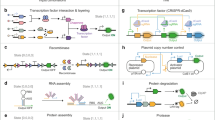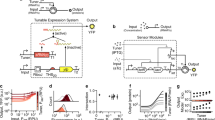Abstract
We seek to couple protein-ligand interactions with synthetic gene networks in order to equip cells with the ability to process internal and environmental information in novel ways. In this paper, we propose and analyze a new genetic signal processing circuit that can be configured to detect various chemical concentration ranges of ligand molecules. These molecules freely difiuse from the environment into the cell. The circuit detects acyl-homoserine lactone ligand molecules, determines if the molecular concentration falls within two prespecifid thresholds, and reports the outcome with a fluorescent protein. In the analysis of the circuit and the description of preliminary experimental results, we demonstrate how to adjust the concentration band thresholds by altering the kinetic properties of specific genetic elements, such as ribosome binding site effiencies or dna-binding protein affnities to their operators.
Access this chapter
Tax calculation will be finalised at checkout
Purchases are for personal use only
Preview
Unable to display preview. Download preview PDF.
Similar content being viewed by others
References
F. M. Ausubel, R. Brent, R. E. Kingston, D. D. Moore, J. G. Seidman, J. A. Smith, and K. Struhl. Short Protocols in Molecular Biology. Wiley, 1999.
B. L. Bassler. How bacteria talk to each other: regulation of gene expression by quorum sensing. Current Opinion in Microbiology, 2:582–587, 1999.
A. Becskei and L. Serrano. Engineering stability in gene networks by autoregulation. Nature, 405:590–593, June 2000.
M. Elowitz and S. Leibler. A synthetic oscillatory network of transcriptional regulators. Nature, 403:335–338, January2000.
W. C. Fuqua, S. Winans, and E. P. Greenberg. Quorum sensing in bacteria: The luxr-luxi family of cell density-responsive transcriptional regulators. J. Bacteriol, 176:269–275, 1994.
T. Gardner, R. Cantor, and J. Collins. Construction of a genetic toggle switchin escherichia coli. Nature, 403:339–342, January 2000.
M. Ptashne. A Genetic Switch: Phage lambda and Higher Organisms. Cell Press and Blackwell Scientific Publications, Cambridge, MA, 2 edition, 1986.
J. Sambrook, E. F. Fritsch, and T. Maniatis. Molecular Cloning: A Laboratory Manual. Cold Spring Harbor Laboratory Press, Plainview, NY, 1989.
H. M. Shapiro. Practical Flow Cytometry. Wiley-Liss, New York, NY, 1995. Third Edition.
R. Weiss and S. Basu. The device physics of cellular logic gates. In NSC-1: The First Workshop of Non-Silicon Computing, Boston, Massachusetts, February 2002.
R. Weiss, G. Homsy, and T. F. Knight Jr. Toward in-vivo digital circuits. In Dimacs Workshop on Evolution as Computation, Princeton, NJ, January 1999.
R. Weiss and T. F. Knight Jr. Engineered communications for microbial robotics. In DNA6: Sixth International Workshop on DNA-Based Computers, DNA2000, pages 1–16, Leiden, The Netherlands, June 2000. Springer-Verlag.
Author information
Authors and Affiliations
Editor information
Editors and Affiliations
Rights and permissions
Copyright information
© 2003 Springer-Verlag Berlin Heidelberg
About this paper
Cite this paper
Basu, S., Karig, D., Weiss, R. (2003). Engineering Signal Processing in Cells: Towards Molecular Concentration Band Detection. In: Hagiya, M., Ohuchi, A. (eds) DNA Computing. DNA 2002. Lecture Notes in Computer Science, vol 2568. Springer, Berlin, Heidelberg. https://doi.org/10.1007/3-540-36440-4_6
Download citation
DOI: https://doi.org/10.1007/3-540-36440-4_6
Published:
Publisher Name: Springer, Berlin, Heidelberg
Print ISBN: 978-3-540-00531-5
Online ISBN: 978-3-540-36440-5
eBook Packages: Springer Book Archive




